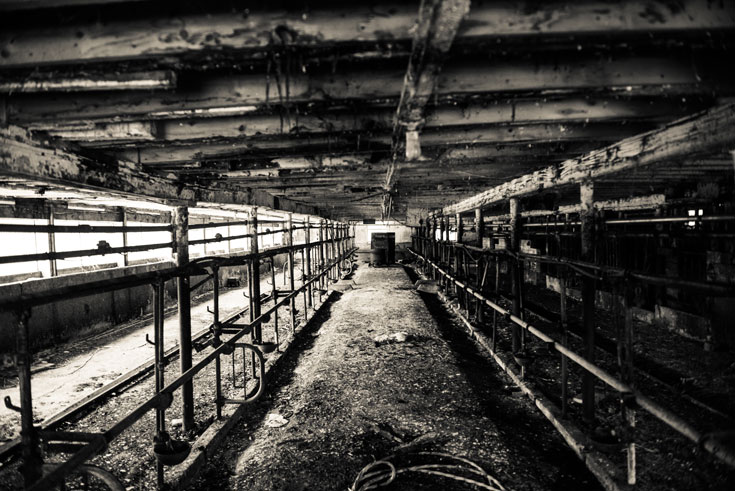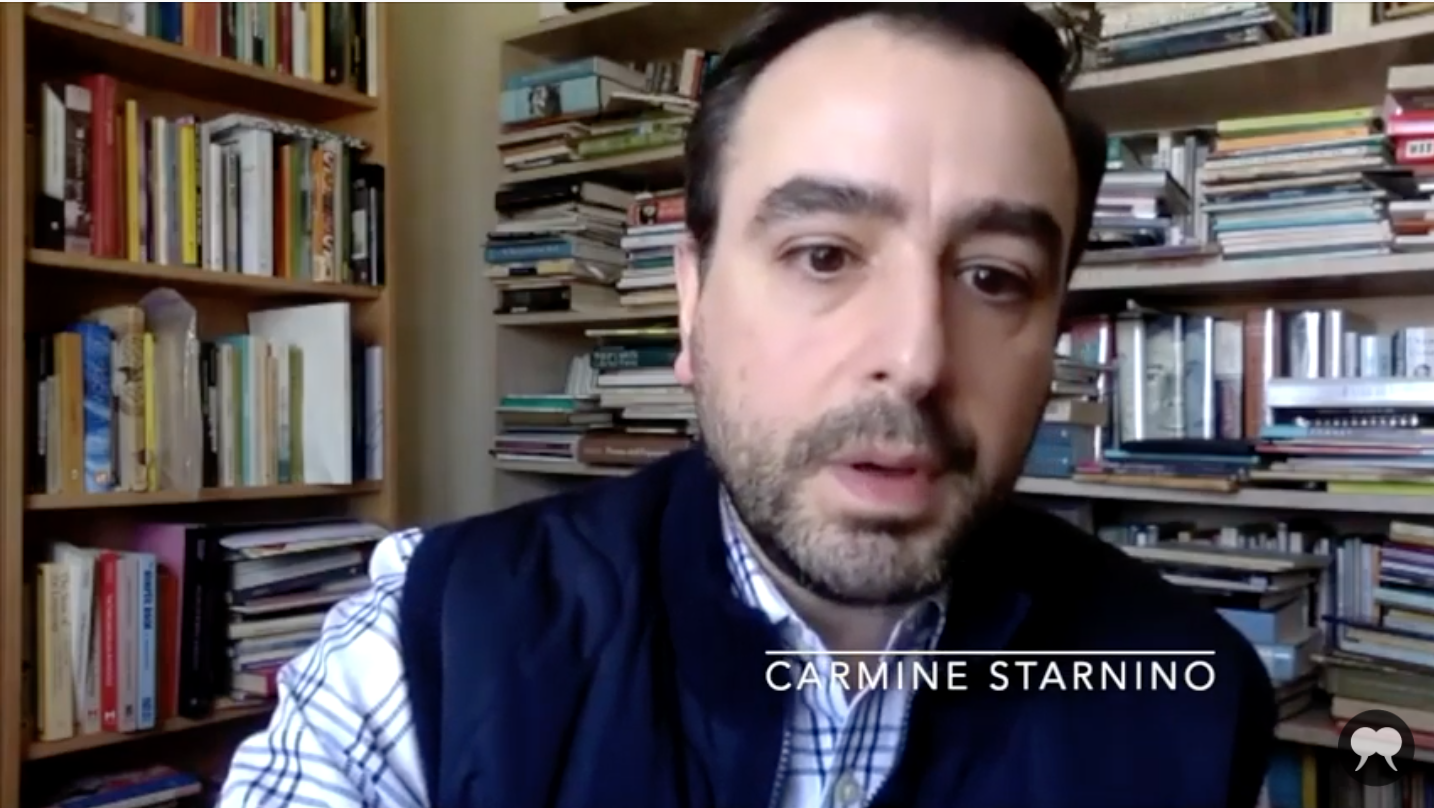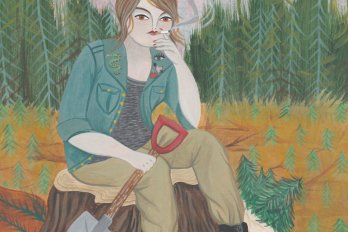It was still dark on October 26, 1991, when Elmer Yuill slid from beneath the patchwork quilt as his wife, Hazel, slept. The seventy-seven-year-old dairy farmer went out to do the barn chores, as he did every morning. In rubber boots, he crunched across frost-laden grass, Becky the black Lab at his heel. At 4:30 a.m., Todd Carlton, the farmhand, found Yuill face down on the concrete. His body was still warm. “I tried to shake him and wake him up,” said Carlton. What he didn’t see, in that moment of shock before running into the house to call for help, was that Yuill had been shot, execution style, in the back.
Listen to an audio version of this story
For more audio from The Walrus, subscribe to AMI-audio podcasts on iTunes.
Twenty minutes later, the ambulance arrived at Elm Knoll Farm, in the community of Old Barns, Nova Scotia. The paramedics were still pumping Yuill’s chest as they raced him to the hospital in the nearby town of Truro. In the waiting room, police delivered the grim news to Hazel. At first, she thought it had been an accident, that Yuill had been struck by a stray round. After all, hunting season had just begun. But, when doctors removed not one but two Tic Tac–size bullets, the truth became clear. Two bullets are no accident. Two bullets are murder.
Carlton, seventeen at the time, had stayed behind. After working at the farm for several years, he knew the sixty swollen udders in the barn couldn’t go ignored for long. He ran down the highway in search of help. At the first farm, John Blaauwendraat roused himself from bed, where he was resting after back surgery, and hobbled to his truck. Yuill was a man beloved for his generosity: a tractor ride for local kids, free milk for the family in a tarpaper shack, a home for the nephew escaping a turbulent life. There wasn’t a farmer in the countryside who wouldn’t do anything for Yuill. Inside the barn, Blaauwendraat noted something odd: on a wooden step were five or six brown beer bottles—curious items, out of place. Yuill never drank and was fastidious about the state of his barn.
Twenty-nine years later, no one has been held accountable for Yuill’s murder. This despite the rcmp using nearly every investigative tool at its disposal, including forensic specialists, criminal profiles, search warrants, and years-long surveillance efforts. Extensive interviews with family members, friends, reporters, witnesses, and former rcmp officers, along with more than 1,000 pages of police and court documents, have helped me piece together a picture of an unsolved crime whose randomness, location, and unlikely victim destroyed a family’s farming legacy and ripped the roots out of a community. It’s hard not to be struck by how much was done to find those responsible and how little was accomplished. In 2017, the Nova Scotia government and the rcmp offered a $150,000 reward for any information that led to an arrest. The money remains unclaimed.
Chris Paley, the now retired rcmp investigator who oversaw the case for seven years in the 1990s, is tormented by it. “Horrific crimes happen all the time,” he says. “But this one—a farmer in his late years minding his farm in the early morning hours being murdered? That’s just terrible.” Now sixty-five, pink skinned and bald with an open face that betrays a certain sadness, Paley says this was the only homicide in his three decades as a cop that didn’t result in a charge. “So many things went wrong in this investigation,” he laments. “These guys weren’t rocket scientists,” he says, referring to the killers. “It just seemed that luck was on their side.”
The shock over the murder had a great deal to do with the victim, the gentle patriarch of a centuries-old family farm. Elmer Dunlap Yuill was born on July 30, 1914. The first of eleven children, he grew up in the white gabled farmhouse that sits back from the road alongside Cobequid Bay. Like many boys of his day, Yuill left school after grade eight to work. During the Great Depression, his father took a seasonal construction job that brought him to various parts of the community, and from his teenage years onward, Yuill ran the farm when his father was gone. “People who didn’t know us thought that he was our dad,” says Georgina Lawson, the youngest of Yuill’s sisters, fifteen years his junior. Yuill drove his siblings to town for ice cream (he liked orange pineapple best) and helped collect the children from school by horse and sleigh during winter storms. As his sisters grew into young women, it was he who waited outside the local dance halls, leaning against his truck, to take them home. On Georgina’s wedding day, Yuill gave her away.
Yuill ran a farm unlike any in the countryside. Cars would pull off the highway to photograph the tidy, picturesque barnyard. Farmers often stopped by for advice. Years of milking by hand had muscled up his forearms. Either too busy or too shy for a serious relationship, Yuill was single until midlife. During a game of bridge one day, Yuill’s sister Norma heard her friend Hazel say that she’d always wanted to live on a farm. “You’ve got to meet my brother!” Norma exclaimed. Two years later, Hazel and Yuill were married in a Baptist church.
They had no children, but by then, Yuill had already helped raise his siblings. And kids were always underfoot, flocking to see him pull a funny face or, from his pocket, a peppermint. The farmer had a sweet spot for his nephew Yuill McGregor. The boy summered on the farm until, one August, when he was eleven, he refused to go home to his troubled life in Toronto, to the father who had sold his coin collection to buy booze and who left his mother’s arms ringed with bruises. McGregor stayed on the farm for a year and then returned again permanently when he was sixteen. Yuill taught him how to sharpen an axe, drive a tractor, birth a calf, and use a scythe to hack Scottish thistle. “He changed my direction in life,” McGregor, now fifty-eight, tells me, sobbing. “He was the only father I have ever known.”
It seems a cruel twist that much of the land Yuill’s forebears were granted, more than 250 years ago, now sits empty. Acadian settlers lived here peacefully among the Mi’kmaq for several decades until the mid-1700s, when the British forced the Acadians out, plundering and burning their homes. When the Yuill family arrived from Boston, in 1765, the only buildings left standing were a few old barns. The name stuck.
Nearly three decades after the murder, the name comes back to haunt. Yuill’s old barn is paint chipped and ramshackle, with letters missing from the Elm Knoll Farm sign. A rusty weathervane creaks. The silo stands like a sepulchre.
Yuill’s murder remains the worst thing the community has ever seen: a respected farmer gunned down, in the twilight of his life, on his own land. The community is small—probably no more than 200 residents—and some officers working the case knew Yuill, from church, from nods on the road into town, or because his kinfolk were so numerous and had such deep roots.
The investigation appeared doomed from the start. By the time police designated the barn a crime scene, it was too late. It had already been contaminated by a troupe of neighbours that arrived to help with chores. But the pressure to solve Yuill’s murder ratcheted up with each passing day as police teams combed the fields and brooks for evidence. The rcmp began a monumental search for the murder weapon. They sifted through a massive manure pile outside the barn with a backhoe and pushed several thousand bales of hay from one end of the barn to the other. Divers scoured the pond inside the abandoned Plumb Hole Lumber Mill. And, as if people weren’t already on edge, Blaauwendraat recalls that a surveillance team began to watch Elm Knoll Farm. The police presence didn’t ease the paranoia. Residents began locking their doors. Farmers stopped milking alone. Trick-or-treating was cancelled.
The rcmp, meanwhile, came up empty. They knew of no motive because Yuill had no enemies. Did the farmer witness a drug drop? Was it a hunter sleeping in the barn? The police bore down on every man in the countryside who had any connection to Yuill. They pulled over Randy Durling as he drove his old beater on the highway. Durling grew up in a tarpaper shack on a corner of Yuill’s property. Police took him back to his camp, deep in the woods, and seized all of his guns. “We went through hell,” says Durling about himself and his brother. Durling’s boss told him not to come back to work cutting trees until the murder was solved. Cops also descended on David Lennerton, who had been near the farm, en route to ask Yuill if he could hunt on his land, the morning the farmer was shot. Police arrived as he was fixing pens in the pig barn at Truro’s agricultural college to question him a third time: What were you doing on the farm that early in the morning? Do you have any idea who did it?
One of Yuill’s nephews, who had been in Maine with his family at the time of the murder, was interrogated for hours on end. Even Blaauwendraat, who could barely stand after his back surgery, was considered a suspect. In his kitchen, police demanded he lay all his guns out on the table. The farmhand, Todd Carlton, faced the same questions multiple times. “Did you ever wish Elmer dead?” police asked. Eventually, Carlton agreed to a polygraph—something police asked many to do.
The investigation stretched on for weeks, then months. The rcmp finally admitted it had no hard evidence to tie anyone to the shooting. Public frustration was palpable. “You can only do so much with so little,” said rcmp staff sergeant George Batt in a June 1992 newspaper interview, pleading with residents to come forward with information. “You can’t manufacture evidence.” In July of that year, 150 people—nearly everyone in the community—turned out to a meeting hosted by the rcmp to unveil a poster promising up to $7,000 in reward money.
It’s hard not to be struck by how much was done to find those responsible and how little was accomplished.
A year later, leads tapered off. Fewer calls came into the rcmp, and eventually, members of the eight-person investigative team were reassigned. It began to seem like it would never be solved.
In October 1993, rcmp sergeant Chris Paley took over the case as the area’s new head of major crime. On his first day, his commanding officer sat him down: he had to do everything in his power to figure out who killed Elmer Yuill. By this time, investigators had taken more than 220 statements and accrued nearly 500 hours of overtime. One officer told the press that, if they added up the costs, they would “probably be staggering.” The crime unit was angry over its lack of progress. Paley was equally frustrated. And, he adds, there’s no such thing as a perfect murder. Sooner or later, he thinks, dna evidence or a witness will help solve it. “There’s always something left behind.”
Paley spent months digging through police documents. He reevaluated interviews, reconsidered witness statements, reassessed leads. He came to understand that the case was not only solvable but that his predecessors had actually come close to cracking it. The year before, as investigators began to cross names off their list of people of interest, they kept circling back to one young man: Duane Deveaux.
A boxer who flipped burgers at McDonald’s, Deveaux lived with his mother on the outskirts of Truro. It’s unclear how police found their way to him. He had no community connection to Yuill and thus would likely not have been on the police’s immediate list of young men to question. Deveaux had an alibi: he had partied with a friend the night before Yuill’s murder, drinking in Truro until closing at 2 a.m. Deveaux told police he had been dropped off at home and had gone to bed around 3 a.m.
Yet police began receiving tips that caused them to take a closer look at Deveaux. Redacted witness statements feature an individual who shares aspects of Deveaux’s temperament and alibi. On the day Yuill was found dead, one witness described a suspect who, smiling and cocky during a game of pool at a Truro bar, called the farmer’s death “the perfect murder.” The same suspect, according to another witness, said that the farmer had been shot in the back of the head or shoulder area and that no shells had been left behind. The suspect said it had happened in the barn, right where you walk in. Yet another witness shared that the same suspect had told him the barrel of the gun used against the farmer had been changed so it couldn’t be traced.
In the summer of 1992, police executed a search warrant at Deveaux’s home. In his interview with me, Bernard, Deveaux’s older brother, recalls that investigators found what they believed could be the weapon used in Yuill’s murder: a disassembled .22-calibre rifle, missing its barrel—the part needed to trace the bullets retrieved from Yuill’s body. According to Bernard, his mother grew suspicious of the attention Deveaux was receiving from the police and went to speak to them. A redacted statement with details consistent with Deveaux’s alibi captures a conversation between rcmp officers and someone who appears to be the mother of a suspect. She explains she had “tried different ways to see if I could find out” what the suspect knew.
Then came a breakthrough. In January 1993, rcmp travelled to pei to gather a statement from Deveaux’s cousin Mark Petrie, who gave police new information that tied Deveaux to the murder. Petrie told police that, in the summer of 1991, months before Yuill’s murder, Deveaux had pleaded with him to sell Deveaux his gun. He wanted to scratch off the serial number and use it for a heist. Petrie refused. Five months later, Deveaux explained to Petrie over beers how the farmer had been killed. Two men had robbed a store, Deveaux said, and, to avoid police, had hidden out in a barn. When the farmer came to investigate, he had a pitchfork. The guys confronted him and one of them shot him.

“He was excited and right enthused about the whole thing,” Petrie told police in a redacted statement he later authenticated with me. “He figured it would never be solved because the police would never be able to connect the murder and the robbery because they really had nothing to do with each other.” Petrie remembers that his cousin had, in fact, bragged to him about knowing who killed the farmer. It was a friend of his, Deveaux said, then speaking vividly about the angle at which the bullet had entered Yuill. “He was pretty detailed about it,” Petrie tells me. “The only way you could be that detailed about it would be if you were there, in my opinion.”
As it happened, Truro police had been investigating an armed robbery that occurred hours before Yuill was murdered. At 10:15 p.m. on October 25, 1991, a store manager locked up the Ryan’s iga grocery store in Truro, about a thirty-minute drive from Old Barns. He was walking toward his car to make the Friday-night deposit when he heard a shuffling of feet. A man with pantyhose over his face and socks on his hands bumped up against him. “Put the money in the bag—I’ll shoot you!” the manager remembers the man saying, pointing a gun from his hip. The manager dropped the deposit into a navy duffle-like bag and the man bolted. Two weeks later, a similar bag and a sawed-off 16 gauge were found about a kilometre from the Ryan’s iga. Police believe it was the same weapon levelled at the store manager. A redacted document from December 1992 describes how, during questioning by the rcmp for the armed robbery, a suspect identifies the bag as his. A “blue duffle bag” is later included as evidence in a court document charging Deveaux for the crime.
With Petrie’s statement, the rcmp felt like it was finally on the right track and began a joint investigation with the town police. On March 5, 1993, according to Bernard Deveaux, the rcmp drove to the plastics plant in Truro, where his brother was working, and arrested him in connection with the murder of Elmer Yuill and for the Ryan’s iga robbery. Redacted documents from an interrogation dated the next day include enough details of Deveaux’s alibi to indicate him as the suspect being questioned. After more than twelve hours, Deveaux finally relents. He admits to robbing the store manager, saying it had been planned by a former employee of Ryan’s iga who had waited “down the road” on lookout. But the admission wasn’t enough for his interrogator, a Truro police constable named Todd Taylor and Deveaux’s former boxing coach. “I’ll be straight up with you,” Taylor said. “If you can provide information leading to much bigger things than what you’re involved in here, okay then, yes, things can happen. . . . Ultimately, I’m looking for information as well on the murder of Elmer Yuill, okay?”
Taylor presses. “You weren’t in the barn?”
“No, never was,” replies Deveaux.
Taylor presses again. “I think you know more about the Elmer Yuill murder than you’re saying.”
Deveaux appears to concede. “Well, I would have to talk to my lawyer and all that before, you know.”
Taylor tells Deveaux “a solid case” is being built against him for murder, warning, “You’re gonna have to tell us something that’s gonna change our mind of that” and explaining various scenarios in which Deveaux could be eligible for manslaughter even if he weren’t the one who pulled the trigger. Then, in a surprising admission, Deveaux agrees to plead guilty to both the armed robbery and a “murder three charge”—or manslaughter.
Police ultimately felt they did not have enough to convict Deveaux for murder and instead charged him solely with the robbery. He would later plead not guilty despite having apparently confessed to the holdup. While nothing in the police documents shows that the confession was disputed or recanted, there might have been grounds to challenge Deveaux’s interrogation as coercive. No lawyer appeared to be present. Different police officers questioned Deveaux in two consecutive sessions, with the confession itself occurring in an unmonitored room.
In the ensuing months, more evidence emerged that appeared to connect Deveaux to the robbery. Clothes found near the scene on the night of the holdup included white high-top sneakers. Among the materials is a redacted report on those shoes that matches up with other documents charging Deveaux with the robbery. After comparing the white high tops to a pair of Deveaux’s winter boots, forensic specialists concluded they were likely worn by the same person.
The trial was scheduled and dozens of witnesses lined up, including Deveaux’s mother, his now deceased stepfather, and his cousin Mark Petrie. But, in September 1993, during pretrial meetings, the Crown stayed the charges—meaning they decided against proceeding with the case but did not withdraw the charges. After hearing evidence from the police, the Crown believed Deveaux’s involvement in Yuill’s murder was far more extensive than he let on and that pressing ahead with the robbery prosecution might harm any chance of assembling a bigger case against him. “It was determined that it was in the best interest of the rcmp homicide investigation, and the crown’s case, to stay the charges,” states a Truro police document.






